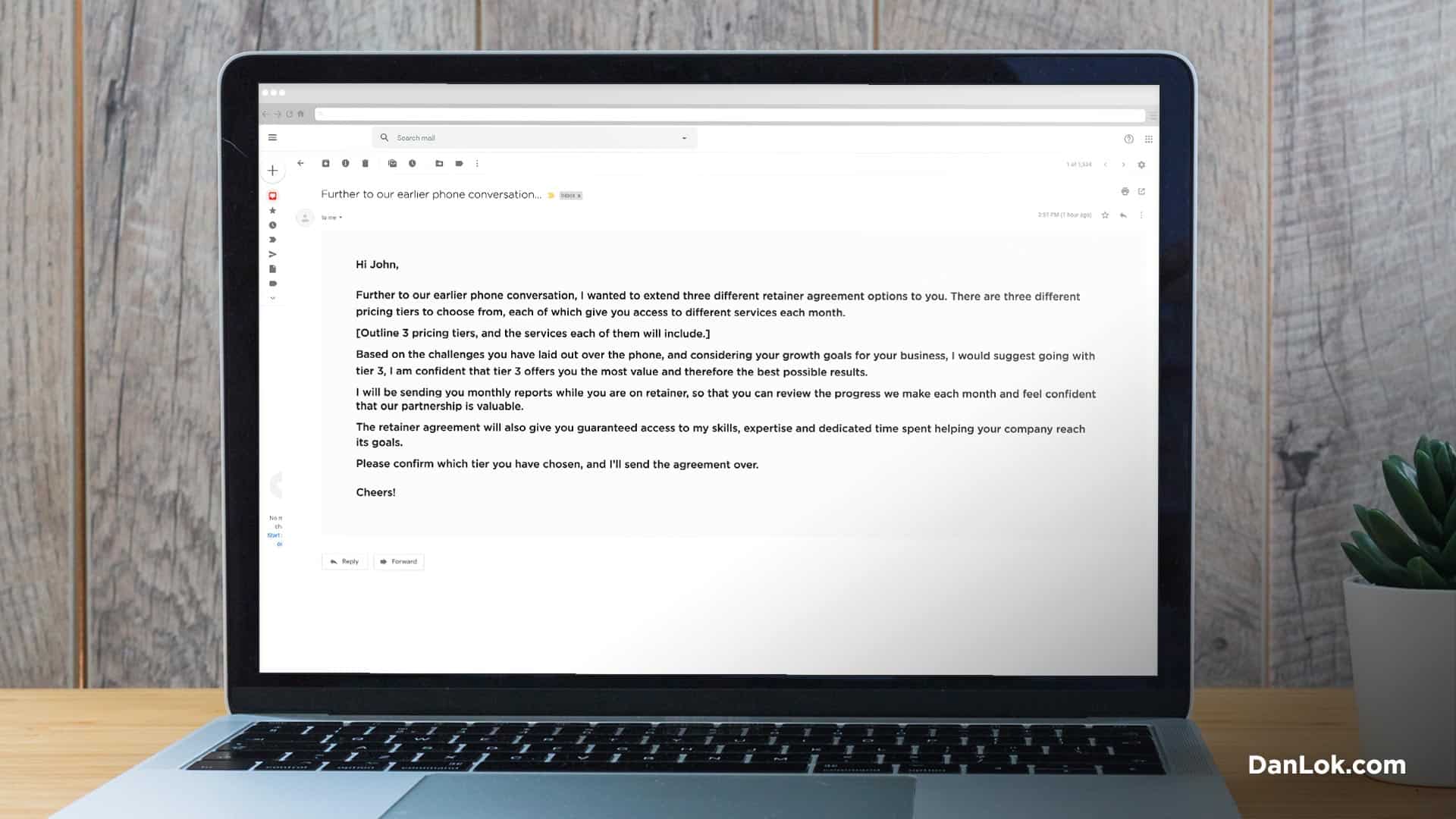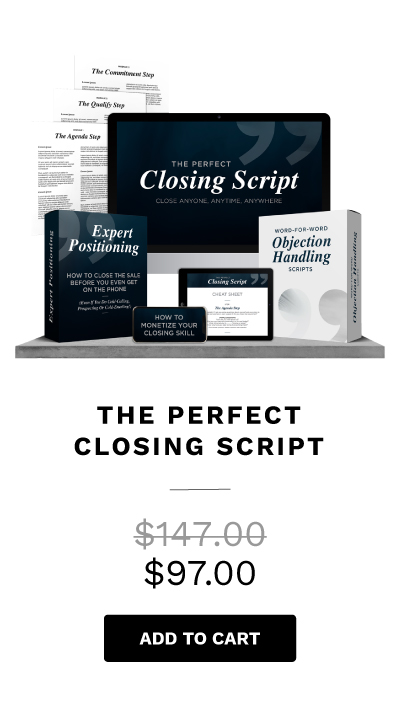Are you a freelancer or independent contractor who is currently only closing clients on a per-project basis?
Do your clients only pay you once you complete a project, and are they often late paying your invoices?
If so, it’s time to learn how to negotiate a retainer agreement with your clients. I believe that closing clients on a monthly retainer fee is the best business model for freelancers, or anyone trying to succeed in the gig economy.
Closing clients on a monthly retainer fee is the best business model for freelancers, or anyone trying to succeed in the gig economy. Share on XRetainer contracts are formal, written agreements made between a freelancer, consultant or independent contractor and their client.
A retainer agreement means that the client is agreeing to pay for your services in advance, thus retaining your services.
A retainer fee is a fixed fee that the client agrees to pay based on their anticipated need for your services, and the anticipated volume of work.
The fixed fee is either a single advance payment, a recurring monthly fee, or an annual fee.
The benefit of successfully negotiating a retainer agreement for the freelancer is obvious: Guaranteed, predictable, and consistent income that they can count on.
It’s not just the freelancer who prefers being paid via a retainer fee. Many clients prefer retainers, too. Why? Because it means they’ll secure your services.
Essentially, the client is securing your commitment with a retainer fee.
Your clients are promising advance payment in order to hold your services for a given period of time.
Why would a client want to pay in advance to guarantee your dedication to them? It’s usually because you have a highly sought-after, in-demand skill – or it’s because you’re great at what you do.
If the client perceives your services or your specific skills to be in high demand, they will be motivated to sign a retainer agreement to ensure they don’t lose you to a different client who was willing to sign one.
That’s why people with high income skills are successful at closing retainer contracts.
If the client perceives your services or your specific skills to be in high demand, they will be motivated to sign a retainer agreement to ensure they don’t lose you to a different client who was willing to sign one. Share on XShould You Propose a Retainer Agreement to New Clients?
If you have a few clients who currently give you steady work each month, it’s completely appropriate to propose a monthly retainer fee. But what about new clients? You might feel nervous asking a new client to sign a retainer agreement.

Freelancers often feel more comfortable proposing retainer agreements to existing clients with whom they’ve already built a good rapport, and clients who already regularly request their services.
It’s these clients who are more likely to see the value of formalizing an agreement and developing a long-term partnership.
New clients, however, might be less likely to agree to retain your services, since they haven’t yet seen how skilled you are.
But is it still possible to convince a new client to sign a retainer agreement? Absolutely.
I’m going to give you a few tips for negotiating a retainer agreement with a new client, as well as some examples of retainer agreements and how they work. But first, let’s discuss some of the main benefits for clients who sign these types of agreements.
Benefits For Clients Who Agree On A Retainer Fee
If you’re going to close a client on signing a retainer agreement, you should be able to articulate the benefits to them. So, what are some of the benefits of retaining your services?
Think of the retainer contract as a down payment for future services. The retainer secures your services, and your loyalty. As I said earlier, this is beneficial if your skills are in high demand.
The retainer secures your services, and your loyalty. Share on XThe benefits for your clients who retain your services are obvious if you really think about it. I want you to imagine that you are a high income copywriter. Copywriting is your gift, and you have therefore decided to pursue a career as a freelance copywriter.
If a potential client knows they’ll be using your services a lot, because they often need sales newsletters written, brochures written, and press releases written, what should that client do?
The answer is obvious: Put you on retainer. This way, they won’t have to contact you to get a quote every time they need something written.
Instead, they can simply pick up the phone, call you, and get you going on writing it for them right away. You’re on retainer, so of course you’ll get going right away, as soon as they need something written up.
It’s easier for you, and it’s also easier for the client.
You can position your monthly retainer as a necessary recurring payment to ensure that the client gets your time, easy access to your services, your dedication and your ongoing loyalty.
For example, if one of their competitors wants to hire you, you’re less likely to be swayed if you’re already on retainer with your client.

Preventing talent poaching is a real motivator for clients to sign a formal agreement.
If your client is automatically paying you a monthly retainer fee, you will be much less likely to be poached by one of their competitors.
You can offer your clients extra services that you reserve for your retainer clients, such as a few hours of consulting each month, monitoring services if they have active marketing campaigns that need tracking, media outreach on their behalf, and more.
Your clients will also get the most value from your services if they use them every month on an ongoing basis, and monthly retainer agreements encourage clients to do this.
Benefits For Freelancers Getting Paid Via Retainer
A monthly or annual retainer fee is the ideal way to get paid if you want to succeed in the freelance economy, for many reasons.
First of all, it’s guaranteed income, and it’s often set up as guaranteed steady income.
This reduces the uncertainty when it comes to cash flow, budgeting, and your monthly income.
Additionally, it’ll make your life easier when you no longer have to remember to invoice your clients, and it’s also nice to no longer have to chase clients for payment.
Using retainer agreements as your payment model will help you sleep better at night. It’s a very comfortable and safe position to be in as a freelancer.
Once you start using retainer agreements as your payment model, you’ll wonder how you ever survived without them. You’ll wonder why you didn’t think of this sooner. Share on XIf you used to have a traditional 9-5 job, you probably took for granted the predictability of automatically getting paid every two weeks.
The reality is that most freelancers don’t know when they’re going to get paid for their work. It’s simply not very predictable when you’re a freelancer. But retainer agreements change everything.
With retainer fees in place, predictable payment is a perk the freelancer reclaims.
With a retainer agreement and automated payments in place, you’ll become more motivated to dedicate your time to your clients. It encourages the client not to go dormant on you, and it also encourages you not to go dormant on them.

Financial freedom is the number one benefit of having clients on retainer agreements.
No longer will you have thousands of dollars in unpaid invoices, putting limits on the way you live your life while you wait to get paid.
No longer will you be scrambling to get invoices paid in time for your rent and other fixed monthly expenses to come out of your account.
If you need funds to book a vacation or make a big purchase, you’ll already have those funds available, and you won’t have to wait to get paid first.
Once you have that financial freedom gained from securing a few retainer clients, your life will get much easier, and your business will grow.
Let’s say you have three clients on retainer. All three of them pay you an agreed-upon lump sum on the 1st of each month.
One of them pays you $2,000 per month, one of them pays you $3,000 per month, and one of them pays you $5,000 per month.
You now have $10,000 per month of guaranteed income.
Receiving these lump sum payments each and every month in the form of retainer fees, exactly when you are expecting them, helps you budget and grow your business.
Financial freedom is the number one benefit of having clients on retainer agreements. No longer will you have thousands of dollars in unpaid invoices, putting limits on the way you live your life while you wait to get paid. Share on XWhich Clients are Good Candidates for Retainer Agreements?
If a client will indisputably have an ongoing need for your services, then they’re a great candidate for a retainer agreement.
Your client might have a blog that needs new content on a weekly basis, social media accounts that need daily post, monthly marketing initiatives that need to be written and monitored, or a bi-weekly newsletter that must be compelling and engaging.
Any client who is looking to grow their business, and needs monthly upkeep and monthly services in order to grow their business is a good candidate for a retainer agreement.
As long as the client is willing to set aside a certain budget – a fixed monthly fee – for the purpose of meeting their growth goals, they should be open to paying an ongoing retainer fee.
If a client will indisputably have an ongoing need for your services, then they’re a great candidate for a retainer agreement. Share on XHow To Negotiate a Retainer with New Clients: Why Should They Pre-Pay Before Seeing Results?
With new clients, you’ll have to be able to intelligibly communicate your value in order to convince them to pre-pay before seeing results. Perhaps you have client testimonial videos you can show your new clients, or reference letters from past clients.
It is possible to convince a new client to sign a retainer agreement, but first you’ll have to make your client feel comfortable and confident.
To make your client feel comfortable with this type of payment model, you’ll have to have established some rapport with them first, either via phone conversations or a couple of in-person meetings.
You’ll also have to exude confidence and clearly lay out what your value is. What will you be offering them each month? What will your monthly deliverables be?
A big reason why some clients are willing to pre-pay before seeing results is if your specific set of skills are not only in demand, but also exactly what they’re looking for.
You can explain to a potential client that your services are in high demand, and because of the limited space in your schedule, you’re currently only taking on retainer clients.
Before you try to close a new client on a retainer agreement, take some time to identify what some of their current pain points and challenges are.
From there, you should clearly communicate exactly how your services can help solve these problems, and why.
Types of Services That Would Be Most Efficient Under a Retainer
There are certain freelancers who have an easier time landing retainer clients than others because the service they offer is a type of service that would be most efficient under a retainer agreement. This is typical because it is a service that requires ongoing work or ongoing maintenance.
Social Media Managers, for example, offer a service that requires consistent monthly effort.
A monthly retainer would make sense because they need to post several times per week on their client’s social media pages, monitor social media marketing campaigns, and consistently engage with the community to attract followers.
Content Writers who write for company blogs on a freelance basis could easily get retainer agreements signed since most of their clients require a certain number of blog posts per month on an ongoing basis.
If the client knows their blog needs a set number of posts per month, they won’t mind retaining their writer’s services if that writer consistently produces great content.
Copywriting is another service that typically requires ongoing work each month, and is therefore well-suited for retainer agreements. High income copywriters offer various services that are required on an ongoing basis.
These services include writing advertising copy, press releases, newsletters, direct copy for marketing materials, copy for brochures, and website copy.
Website maintenance services are also required monthly, on an ongoing basis, which is why many clients wouldn’t argue that it would make sense to retain the services of their website specialist.
Web developers often are retained in case emergency website services are required to quickly get their client’s website back up and running, or to fix website issues quickly.
Those are just a few examples of services that work well on retainer.

How Much Should a Retainer Fee Be?
How much is a retainer, on average? It depends on what service you are offering.
Freelancers with a high income skill such as website development, Instagram marketing or SEO copywriting could charge their clients a monthly retainer fee of $10,000 per month.
If you’re not quite at an expert level in your industry yet, you might not be able to charge $10,000 per month yet.
How much should your retainer fee be if your skills are good, but not at the expert level yet?
A good rule of thumb is to charge at least $3,000 per month for your retained clients because this way you’ll only need 3 clients to sign retainer agreements in order to earn a six-figure income.
Your goal should be to develop high income skills so that each client is paying a $10,000 per month retainer fee.
Another option is to offer your clients different pricing tiers, where the retainer agreement starts at $3,000 per month, but can be as high as $10,000 per month depending on which tier your client chooses.
Pricing tiers give your client options to add on services that they find valuable.
Let’s take the Social Media Manager’s services as an example.
Tier 1 for $3,000 per month might include content creation, graphic design, daily scheduled posts, and strategic social media promotion.
2nd Tier for $5,000 per month would include everything tier 1 offered, as well as daily community engagement, strategic growth strategies, and marketing campaign monitoring.
Tier 3 for $10,000 per month would include everything tier 1 and 2 offered, as well as influencer outreach, strategic collaborations, partnership agreements, video creation and daily community management.
Your goal should be to develop high income skills so that each client is paying a $10,000 per month retainer fee. Share on XCommon Objections to Retainer Fees
What should you do if a potential client is interested in working with you but hesitant to start things off with a retainer agreement?
The first thing you want to do is find out what their objection is.
Is it about the money? Are they hesitant to fork over that much money in advance, or worried about the high price?
Or, is it about value? Are they unsure of the value, because they haven’t worked with you before? Or, is it about results, and they aren’t sure they’ll get the results they’re hoping for?
If it’s about the money, do not offer them a discount.
Some clients might mistakenly assume that signing a retainer agreement comes with a discount on your services.
As a skilled consultant or contractor, however, you should never offer a discount.
You can offer a special package of different services, but don’t use the word ‘discount’. Offering a discount will only cheapen the perceived value of what you are offering.

Add value to your offer instead of offering a discount. They will still see this as getting a good deal, but you’ve avoided using language that cheapens your offer.
There are many ways you can add value to your offer, for example by offering additional services.
A freelance content writer, for example, is suddenly more valuable if they offer SEO-friendly content and add their SEO strategies to their writing offer.
When the client starts thinking about the value they’ll be getting, the money they’re spending suddenly starts to matter less. Share on XYou can also say to the client, “Are you looking for a good price, or are you looking for results? My services are in demand, because very few people are as good as I am. So if you don’t want to sign an agreement with me, it’s perfectly ok, but I’m only taking on retainer clients at the moment.”
If the client says they are hesitant because they haven’t seen what kind of results you could produce, my advice is to offer them a trial period.
Not a free trial, because you should never give anything away for free. A trial can involve a one-time payment for the completion of a certain task or project. If the trial goes well, why wouldn’t the client want to continue?
In general, if a client has objections to this payment model, it’s your job to keep reminding them of the various benefits.
Focus on benefits to the client, such as the fact that you’ll now have a set number of hours per month that will be dedicated to them, and they’ll have guaranteed access to your services.
How To Close Clients on The Idea of a Retainer Agreement
How do you sell your client on the payment model of a retainer agreement? Should you propose the idea of a retainer fee via email, in person, or over the phone?
Closing clients in person isn’t always possible, especially if your client lives in a different city.
Don’t worry about that, though. The best way to close clients on paying you via retainer is to first introduce the idea over the phone. Then you will follow up with an email.

Below is a step-by-step guide for closing your client on a retainer agreement:
Step 1: Schedule a phone call with the decision maker. (There is no point even talking about the idea of a retainer agreement to anyone except for the decision maker.)
Step 2: Before you get on the phone with the decision maker, prepare an answer to the question… “How does a retainer agreement work?”
Step 3: Once you’re on the call with the decision maker… The first thing you’ll ask them is how much work they anticipate over the next 3-6 months. Ask what their goals are for the next 3-6 months. Help them estimate the volume of work that will be required in order to accomplish these goals.
Step 4: Suggest additional monthly services that could be of value to the client… In addition to what they’ve already mentioned they’ll need. Explain that you could offer these services as well.
Step 5: Tell the client that you’ll come up with a flat monthly fee that will cover all these services. Explain that the fee will cover the anticipated volume of work.
Step 6: Explain that what makes the most sense is a retainer agreement where the fee is paid each month. Wait for the client to ask, “How does a retainer agreement work?”
Step 7: Confidently explain how a retainer agreement works, making sure to include all of the benefits to the client. Explain that a monthly retainer agreement means the client is retaining your services. This guarantees access to your time, skills and expertise on an ongoing basis. Remind them of other benefits. They are saving time, getting more of your availability, loyalty and dedication. They are lessening the amount of paperwork, and speeding up the task turnaround time. Getting quotes or purchase orders will no longer be necessary,
Step 8: At this stage, the client will likely ask, “How much will the monthly retainer be?” This is when you explain that you will be sending them an email. They will receive three different monthly retainer fees. Each of which involves different options in terms of workload, monthly tasks, and add-on services.
Step 9: End the call and start working on your email proposal, with three different retainer agreement options for the client to choose from.
Here is an example email template:

“Hi John,
Further to our earlier phone conversation, I wanted to extend three different retainer agreement options to you. There are three different pricing tiers to choose from, each of which give you access to different services each month.
Based on the challenges you have laid out over the phone, and considering your growth goals for your business… I would suggest going with tier 3. I am confident that tier 3 offers you the most value and therefore the best possible results.
While on retainer, I will be sending you monthly reports. This way you can review the progress we make each month and feel confident that our partnership is valuable.
The retainer agreement will give you guaranteed access to my skills, expertise and dedicated time spent helping you reach your goals.
Please confirm which tier you have chosen, and I’ll send the agreement over.
Cheers!”
How To Keep Your Retained Clients Happy
Encourage your retainer client to clearly lay out their expectations.
What results do they need to see every month, to make their monthly retainer fee a worthwhile expense? Make sure you discuss what the monthly deliverables need to be, in order for the client to be happy.

For example, let’s say a client is retaining your services as a Social Media Manager.
Perhaps they’re happy to pay your monthly fee as long as they see specific results. This could include a certain number of new followers per month (growth). Or a certain number of post shares per month (engagement). And a certain number of conversions per month (leads from social media that convert to paid clients).
Your client might be too busy to track these results themselves.
However, that doesn’t mean they won’t notice if you fail to inform them that your monthly goals aren’t met. It is your job to keep track of your progress and results.
It is also your job to send your client monthly progress reports. If a client is too preoccupied to ask for reports, it’s still your responsibility to ensure you’re meeting goals.
It is still your job to ensure you’re sending reports. If you don’t, then you will burn bridges with your clients.
Don’t take advantage of clients who give you leniency. That is them trusting you to do what they are paying you to do. Never take a client’s trust for granted.
Summary
If your clients currently only pay you upon project completion, and they often make late payments… It’s time to change your payment model to a retainer agreement.
Negotiating a monthly retainer agreement is the best payment model for freelancers.
Retainer contracts are formal, written agreements made between a freelancer, consultant or independent contractor and their client.
A retainer agreement means that the client is agreeing to pay for your services in advance, thus retaining your services.
A retainer is typically a fixed monthly fee that the client agrees to pay based on an anticipated work volume.
Benefits for clients on retainer.
The retainer secures your services, and your loyalty. This is beneficial to the client if your skills are in high demand.
They might lose you to a different company who was willing to sign a retainer agreement, if they don’t sign one.
Your monthly retainer is necessary to ensure that the client gets your time, easy access to your services, dedication and your ongoing loyalty.
Which clients are good candidates for retainer agreements?
If a client will have an ongoing need for your services, then they’re a great candidate for a retainer agreement.
A client will be open to a retainer agreement if they want to achieve certain business goals. They are looking to grow their business, and are willing to set aside a certain fixed budget per month.
Yes, you can propose a retainer agreement to new clients.
With new clients, you’ll need to communicate your value in order to get them to pre-pay before seeing results.
You’ll have to make your client feel comfortable and confident with this payment model.
Confidently lay out what your value is. What will you be offering them each month? What will your monthly deliverables be?
Benefits of retainer payments?
Financial freedom is the number one benefit of having clients on retainer agreements. No longer will you have thousands of dollars in unpaid invoices. No more limits on how you live your life while waiting to get paid. It’s a very comfortable position to be in as a freelancer.
It is possible to close new clients on retainer agreements, which is the most ideal payment model for freelancers. Start getting paid on your terms, and you’ll get that much closer to financial freedom.
Learn How To Close More Deals On Your Terms
You deserve to be paid for your work on your terms. You deserve to be paid in advance and retained instead of chasing clients to pay their invoices.
It can be challenging to close deals on your terms sometimes, though. It’s not always easy to close a client on the idea of a retainer agreement.
Sales skills and expert closing skills are required to get retainer contracts signed.
With practice, you too can close more deals on your terms.






